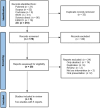Meta-analysis of the efficacy and safety of vamorolone in Duchenne muscular dystrophy
- PMID: 39715964
- PMCID: PMC12003609
- DOI: 10.1007/s10072-024-07939-1
Meta-analysis of the efficacy and safety of vamorolone in Duchenne muscular dystrophy
Abstract
Background: Duchenne muscular dystrophy (DMD) is a severe neuromuscular disorder, often leading to wheelchair dependence by age 13 with limited treatment options, largely relying on glucocorticosteroids. We assessed the efficacy and safety of vamorolone, a modified synthetic corticosteroid, for DMD.
Methods: We performed a systematic review and meta-analysis using seven databases including prospective studies comparing vamorolone with glucocorticosteroids or placebo in DMD patients. We extracted data on efficacy and safety outcomes. We built fixed effects models to assess mean differences. (PROSPERO: CRD42023396908).
Results: Out of 210 identified records, two study reports were included in meta-analysis providing data from 210 patients. Vamorolone at 2.0 mg/kg/day was associated with improvement time to climb four stairs velocity (MD = 0.05 95% CI [0.03 to 0.08] P = 0.0002), and time stand from supine velocity (MD = 0.07 95% CI [0.01 to 0.07] P = 0.007). A higher dose of 6.0 mg/kg/day was additionally associated with higher time to run/walk 10 m velocity (MD = 0.10 95% CI [-0.0.1 to 0.21] P = 0.07, I2 = 0%). Among these beneficial effects only improvement in time to climb four stairs velocity was sustained after a follow-up period of 30 months. Vamorolone did not inhibit growth but increased the risk of weight gain, suppression of adrenal function, and insulin resistance.
Conclusion: The results of our systematic review and meta-analyis are suggestive of improved efficacy and safety of vamorolone for DMD compared to standard glucocorticosteroids but the external validity of these findings as well as the medication's long-term effects remain to be determined.
Keywords: 6MWT; Drug; Muscle; NSAA; Steroid; TTCLIMB; TTRW; TTSTAND; Vamorolone.
© 2024. The Author(s).
Conflict of interest statement
Declarations. Ethical approval and Informed consent: Consent from the ethics committee was not required for the research. Informed consent was not applicable for this systematic review and meta-analysis. Informed consent: Not applicable. Conflicts of interest: The authors declare no conflict of interest.
Figures



Similar articles
-
Efficacy and Safety of Vamorolone in Duchenne Muscular Dystrophy: A Systematic Review.Paediatr Drugs. 2024 Nov;26(6):695-707. doi: 10.1007/s40272-024-00655-5. Epub 2024 Sep 27. Paediatr Drugs. 2024. PMID: 39331339
-
Efficacy and safety of vamorolone in Duchenne muscular dystrophy: An 18-month interim analysis of a non-randomized open-label extension study.PLoS Med. 2020 Sep 21;17(9):e1003222. doi: 10.1371/journal.pmed.1003222. eCollection 2020 Sep. PLoS Med. 2020. PMID: 32956407 Free PMC article. Clinical Trial.
-
Efficacy and Safety of Vamorolone in Duchenne Muscular Dystrophy: A 30-Month Nonrandomized Controlled Open-Label Extension Trial.JAMA Netw Open. 2022 Jan 4;5(1):e2144178. doi: 10.1001/jamanetworkopen.2021.44178. JAMA Netw Open. 2022. PMID: 35076703 Free PMC article. Clinical Trial.
-
Efficacy and Safety of Vamorolone vs Placebo and Prednisone Among Boys With Duchenne Muscular Dystrophy: A Randomized Clinical Trial.JAMA Neurol. 2022 Oct 1;79(10):1005-1014. doi: 10.1001/jamaneurol.2022.2480. JAMA Neurol. 2022. PMID: 36036925 Free PMC article. Clinical Trial.
-
Efficacy of vamorolone in treatment of Duchene muscle dystrophy. A meta-analysis.Front Neurol. 2023 Feb 1;14:1107474. doi: 10.3389/fneur.2023.1107474. eCollection 2023. Front Neurol. 2023. PMID: 36816559 Free PMC article.
Cited by
-
Polypharmacology: new drugs in 2023-2024.Pharmacol Rep. 2025 Jun;77(3):543-560. doi: 10.1007/s43440-025-00715-8. Epub 2025 Mar 17. Pharmacol Rep. 2025. PMID: 40095348 Free PMC article. Review.
References
-
- Birnkrant DJ, Bushby K, Bann CM, Apkon SD, Blackwell A, Brumbaugh D, Case LE, Clemens PR, Hadjiyannakis S, Pandya S, Street N, Tomezsko J, Wagner KR, Ward LM, Weber DR, DMD Care Considerations Working Group (2018). Diagnosis and management of Duchenne muscular dystrophy, part 1: diagnosis, and neuromuscular, rehabilitation, endocrine, and gastrointestinal and nutritional management. Lancet Neurol 17(3):251–267. 10.1016/S1474-4422(18)30024-3 - PMC - PubMed
-
- Verhaart IEC, Aartsma-Rus A (2019) Therapeutic developments for Duchenne muscular dystrophy. Nat Rev Neurol 15(7):373–386. 10.1038/s41582-019-0203-3 - PubMed
-
- Ma J, McMillan HJ, Karagüzel G, Goodin C, Wasson J, Matzinger MA, DesClouds P, Cram D, Page M, Konji VN, Lentle B, Ward LM (2017) The time to and determinants of first fractures in boys with Duchenne muscular dystrophy. Osteoporos Int 28(2):597–608. 10.1007/s00198-016-3774-5 - PubMed
Publication types
MeSH terms
Substances
LinkOut - more resources
Full Text Sources

